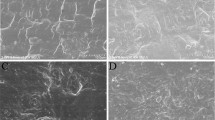Abstract
Water-resistant films were prepared by coating the surface of regenerated cellulose films with castor oil-based polyurethane (PU)/ poly-(methacrylate-co-styrene) [P (MA-St)]. The effects of the ratio of PU to P (MA-St) copolymer on tensile strength (dry and wet states), vapor permeability, size stability, and water resistivity of the coated films were studied. The interfacial interaction between cellulose and the PU/P (MA-St) coating was analyzed using infrared (IR), ultraviolet (UV), scanning electron microscopy (SEM), transmission electron microscopy (TEM), differential thermal analysis (DTA), and electron probe microanalysis (EPMA). The results indicated that the mechanical properties and water resistivity of the coated films significantly enhanced, and the biodegradability was displayed, when the ratio of PU to P (MA-St) was 8∶2 by weight. The chemical bonds and hydrogen bonds between the cellulose, PU, and the copolymer exist in the coated films. It is regarded that PU/P (MA-St) semi-interpenetrating polymer networks (IPNs) were formed, and a shared network of PU with both the cellulose and the coating in the coated film occurred simultaneously resulting in a strong bonding between the coating layer and the film.
Similar content being viewed by others
References
Kosokawa J, Nishiyama M. Biodegradable water-resistant coating materials containing cellulosic fibers. JP 02, 127486, 1990
Koseki H. Biologically degradable water- and oil- resistant paper for packaging. JP 04, 334448, 1992
Hagan L, Celeniano V D. Method of anchoring nitrocellulose surface coating and anchoring composition therefore. U S Pat, 3011910, 1961
O'Brien R N, Hartman K. Air infrared spectroscopy study of the epoxy-cellulose interface.J Polym Sci (Part C), 1971,34: 293–301
Jia Demin, Pang Yongxin, Liang Xi. Mechanism of adhesion of polyurethane/polymethacrylate simultaneous interpenetrating polymer networks adhesives to polymer substrates.J Polym Sci (Part B): Polym Phys, 1994,32: 817–824
Choudhary V, Gupta R. Interpenetrating polymer networks from hydroxy-terminated polybutadiene-based polyurethanes and poly(methyl methacrylate),J Appl Polym Sci, 1993,50: 1075–1082
Klein P G, Ebdon J R, Hourston D J. Polyurethane-polysiloxane interpenetrating networks. 3: polyetherurethane-poly (phenylmethylsiloxane) systems.Polymer, 1988,29: 1079–1086
Hourston D J, Zia Y. Semi- and fully interpenetrating polymer network based on polyurethane polyacrylate systems VI: Polyurethane poly (methyl acrylate-co-ethylacrylate) semi- interpenetrating polymer networks.J Appl Polym Sci, 1984;29:2963–2972
Zhang Lina, Zhou Qi, Water-Resistant film from polyurethane/nitrocellulose coating to regenerated cellulose.Ind Eng Chem Res, 1997,36: 2651–2656
Zhang L, Yang G, Liu H,et al. Manufacture of waterresistant films by using bassage and wheat stalk. Chinese patent CN 1149594A (CO8J 5/18), 1995
Zhang L, Yang G, Yan S,et al. Manufacture of biodegradable regenerated cellulose films with water resistance and excellent strength. Chinese patent CN1091144A (Cl. C08L 97/02), 1994
Zhang L, Liu H, Zheng L,et al. Biodegradability of regenerated cellulose films in soil.Ind Eng Chem Res, 1996,35: 4682–4688
Ritcey A M, Gray D G. Cholesteric order in gels and films of regenerated cellulose.Biopolymers, 1988;27: 1363–1371
Zhang L, Yang G, Fang W. Regenerated cellulose membrane from cuoxam/zincoxene blend.J Membrane Sci, 1991,56: 207–213
Shukla S R, Athalye A R. Mechanical and thermal properties of glycidyl methacrylate grafted cotton cellulose.J Appl Polym Sci, 1995,57: 983–989
Yu X, Chen Q, Geng K,et al. Investigation on structure and properties of interpenetrating polymer networks based on castor oil-polyurethaneActa Polymerica Sinica, 1989, (1): 98–103
Author information
Authors and Affiliations
Additional information
Supported by the State Economy and Trade Commission of China
Gong Ping: born in 1963, Ph. D candidate
Rights and permissions
About this article
Cite this article
Ping, G., Guang, Y. & Lina, Z. Interfacial interaction between polyurethane/poly (methacrylateco-styrene) coating and the regenerated cellulose film. Wuhan Univ. J. Nat. Sci. 3, 92–97 (1998). https://doi.org/10.1007/BF02827523
Received:
Issue Date:
DOI: https://doi.org/10.1007/BF02827523




